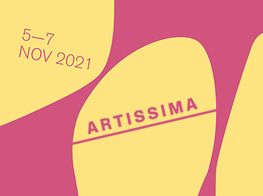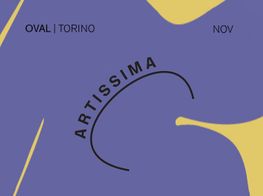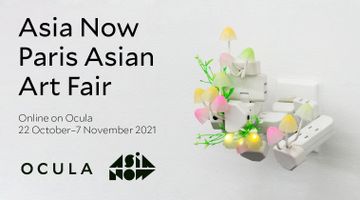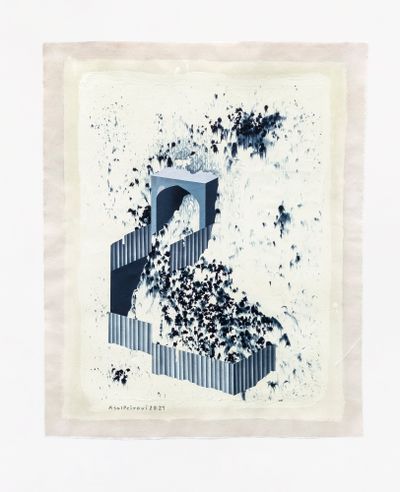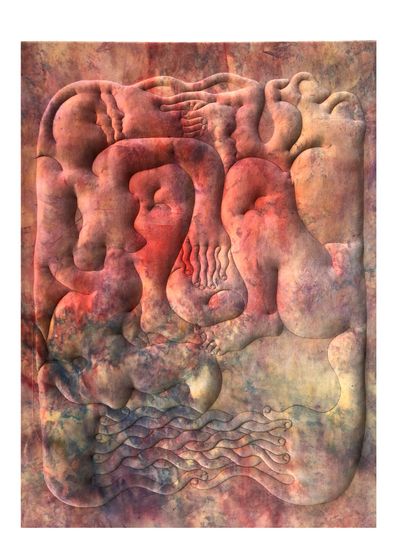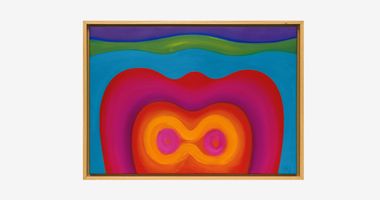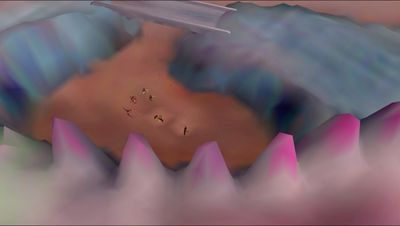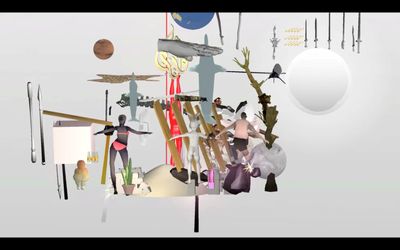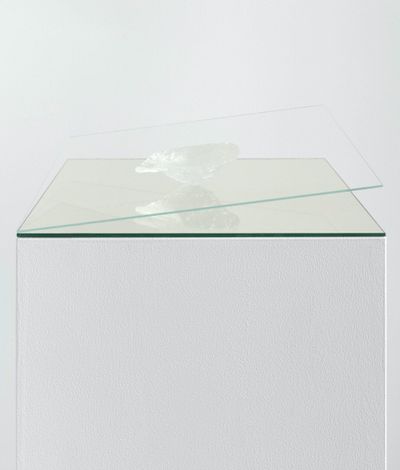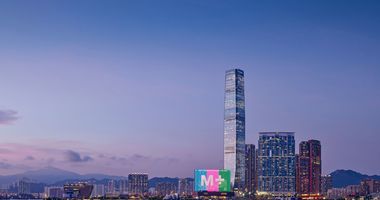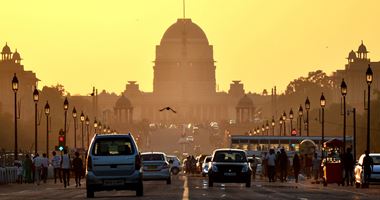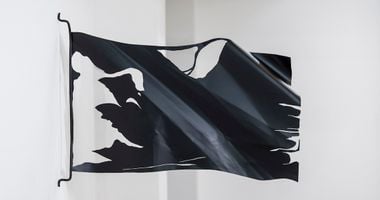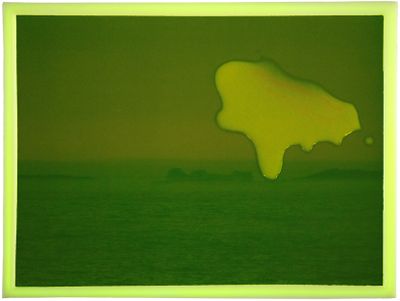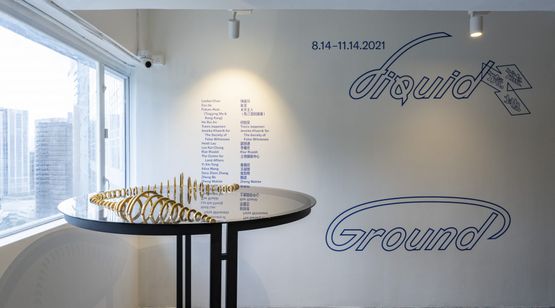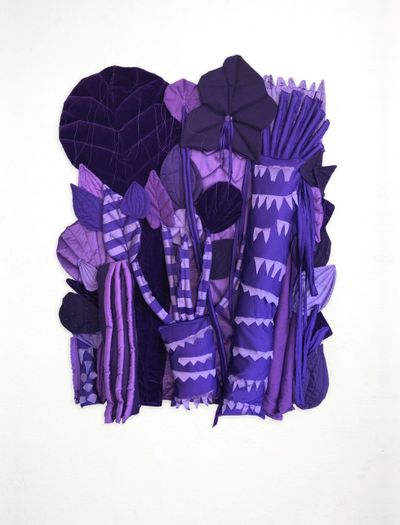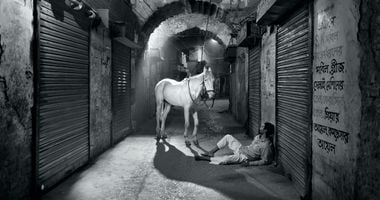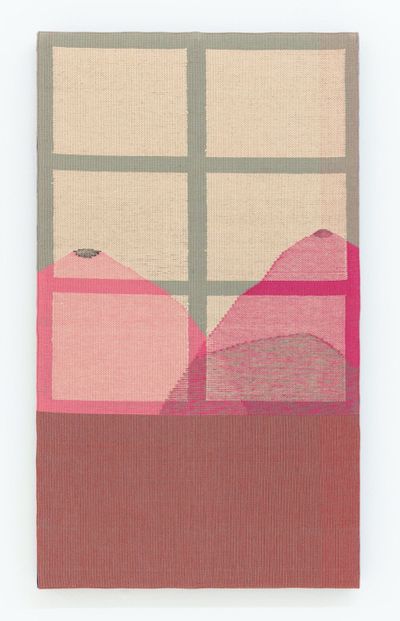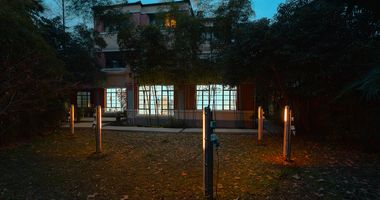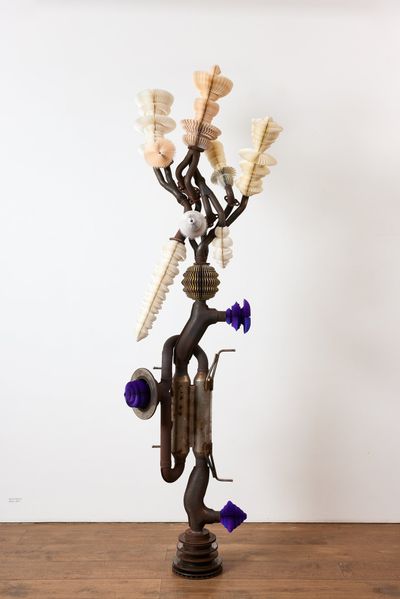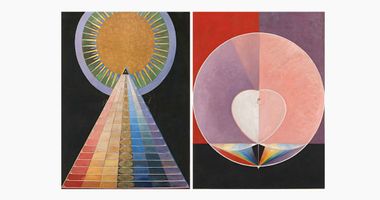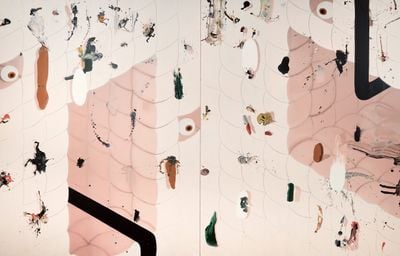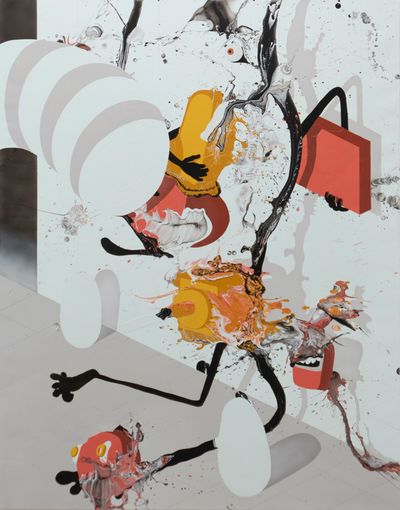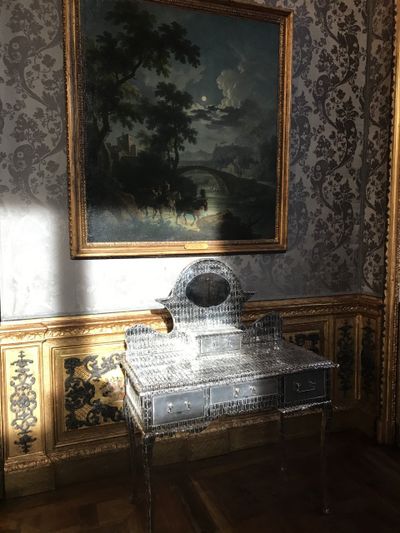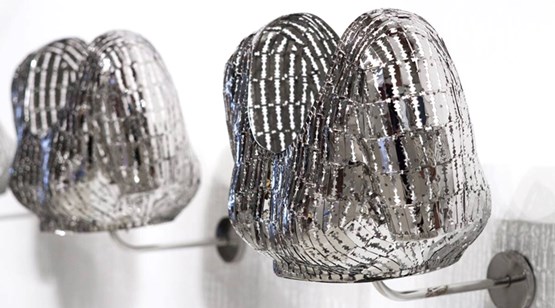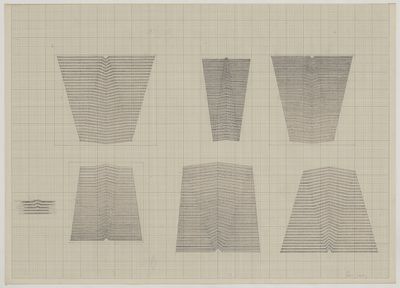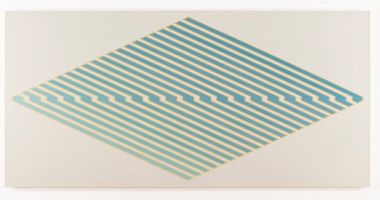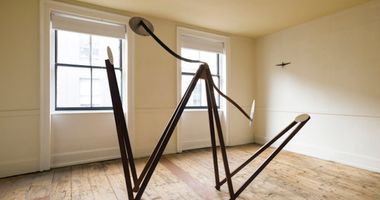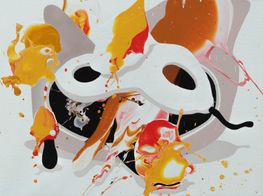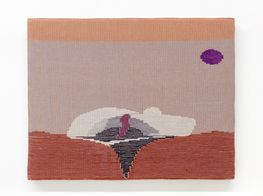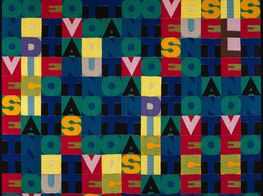Artissima 2021: Artist Highlights
The 28th edition of Artissima (5–7 November 2021) presents 155 galleries from around the world in Turin. Ocula Magazine was on the ground to highlight some of the artists in the fair's main sectors, Hub India, a presentation of over 65 artists in collaboration with 10 leading Indian galleries and museums, and Artissima XYZ.
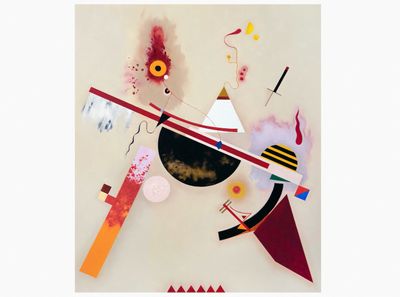
He Wei, Rectangular fire (2021). Oil on canvas. 160 x 130 cm. Courtesy Primo Marella Gallery.
He Wei at Primo Marella Gallery
He Wei's interpretations of the two-dimensional Suprematist planes characteristic of Malevich and Lissitsky are infused with the free-wheeling energy of Kandinsky's more expressive angles.
Kandinsky was inspired by music, using colours and marks to produce exuberant harmonies. That energy has been summoned in paintings at Artissima by the artist, who graduated from Milan's Brera Academy in 2017, and is also showing in Asia Now 2021.
Rectangular Fire (2021) lives up to its name. There's fire everywhere. But in Hypnotised (2021), another historical reference is visible.
A fire engulfing a gold-ochre orb, its marks bleeding into the surface, takes up a top corner, recalling the artist's description of forms of art as 'a bag of vital energy'. A border on this side of the canvas has been left clear and white, save for a scroll of Chinese calligraphy running down the top, like a classical ink painting.
Asal Peirovi at + 2 Gallery
Asal Peirovi's paintings, included in Jeffrey Deitch's online presentation The Future with Gagosian, reference a train journey between her hometown of Sari in Northern Iran, and Tehran, where she studied painting at Shahed University, graduating in 2009.
On unframed and unstretched canvas, modernist architectures simultaneously emerge from and cut into naturalist planes; rural and urban landscapes distilled and reconfigured.
In the case of the blue-tinted paintings shown at Artissima, Summer Snow (2021) features a tunnel opening with an ogee arch, its angular form offset by a landscape built from smooth, ink-like strokes of white that give way to flurries of dark blue tips, flicks, and bleeds.
Another tunnel, this time with triangular lines on terracotta, appears in Overlooking Gadook (2020), jutting out of a blue-white landscape into a pale blue sky—among a group composing the artist's recent show at Chapter NY, with Peirovi's current solo at Standard Oslo on view through 13 November.
Eliška Konečná at eastcontemporary
With all the talk of wet figuration—figurative paintings put to market so fast their paint has barely dried—it's nice to see this 2020 graduate of the Prague Academy of Fine Arts take on the body with confident, material gusto.
Tight stitching bears down on pillowed surfaces constructed from dyed velvet at Artissima, creating strong lines from which fleshy, interconnected forms puff out like soft relief sculptures.
In Monologue (2021), a large piece dominated by a blend of muted and electric pinks, bodies entwine over two large hands, their fingers stretched into interlocking waves. A smaller piece alludes to the action inspiring these bodily portrayals: two fingers press on a slit and two more wrap around a phallic protrusion.
But while the works in focus here are textile, the artist takes her motifs—in particular, hands with curved, stylised digits—into other materials. It should be us (2021) is a stunning wood frame of clouds from which two hands lock indexes.
Rebecca Allen at Arcade, in XYZ Past Future
Before Ian Cheng's live video game simulation Emissary trilogy (2015–2017), or Theo Triantafyllidis' Ritual (2020), in which animals and insects with primitive artificial intelligence live in a real-time simulation, there was Rebecca Allen's The Observer (1999–2019).
Shown at FACT Liverpool as part of you feel me__ (1 November 2019–23 February 2020), the artist describes The Observer as a moving painting. Allen created this digital landscape with a computer system able to generate artificial life, which she developed in the 1990s and named Emergence.
In this ecosystem, land and life evolves according to Allen's rules; far from dystopic, the result is a world of serene and dreamy surfaces, colours, and subtle movements.
Founding Chair of the UCLA Department of Design Media Arts, Allen has been at the forefront of utilising artificial intelligence, algorithms, and other generative models to create art since the 1970s. Yet she staged her first solo with a commercial gallery, organised by Arcade in collaboration with ZELDA, in 2020.
Isaac Chong Wai has an elegant way of expressing severe realities.
In 2018, riot police movements formed the choreography of the performance and video Rehearsal of the Futures: Police Training Exercises (2018), commissioned by Hong Kong's M+ Museum, and included in the inaugural show for the Guangdong Times Museum Berlin space, Times Art Center.
More recently, Wai, who is based in Berlin, was commissioned by the Federal Foreign Office in Germany to create the performance video Falling Reversely (2021): a response to anti-Asian racism amid the Covid-19 pandemic, showing performers falling to the floor and getting back up.
At Artissima, the 'Missing Space' sculptures consist of glass casts of bullet holes from World War II scarring historical sites across Berlin, their protrusions dictating the angle at which their glass sheets rest on mirrors. Each cast is inscribed with a GPS code marking the position of the infliction.
Ghana Shyam Latua at Hub India – Maximum Minimum, The Oval
Khoai Landscape (2021) is a suite of eight works on paper, whose title refers to small hills composed of iron oxide-rich laterite soil found, among other places, in West Bengal, where the artist is from.
Latua's landscapes draw from this geological formation. Sections of red earth built up with delicate ink points are bordered with pin pricks that texture the surface with punctures, before giving way to raw paper ground.
Latua has described his practice as being 'mainly based on the conflict between natural and artificial, man-made environment', with his rural background making 'the poignant sagas of land acquisition' especially important.
'The minimalist beauty of the lateritic landscape of Santiniketan has inspired some of the greatest works of the Bengal school,' journalist Srimoyee Bagchi notes, 'now being lost to urbanization.' With that, Bagchi states, Latua's work is 'both a lament for that loss and a nostalgic recalling of what once was.'
Susi Gelb at Nir Altman
Five images line the wall, each encased in fluorescent plexiglass that glows through luminous polyurethane frames. Three form the 'Reality is Fake' series (2021), with pigment prints depicting a natural element marked at a central point by an epoxy resin blob.
The frame-filling views of sea and desert take on the surface tone of fluorescent green, while that of a river, its light channel offset by the density of its bordering landscape, takes on the shade of a golden lime.
The final two images from the 'Serendipity' series (2021) are orange. Embedded within their plexiglass cases are monotypes of lightly drawn lines that curl and swerve.
A standing LED panel pulls the display together, articulating a sense of liquid time that draws you in, like the green globules rising up and down from a luminous base like a lava lamp, their radioactive light seeping through the cracks of the panel's back making this a sculpture in the round.
Hoda Tawakol at Gallery Isabelle van den Eynde
It's hard not to notice Hoda Tawakol's effervescent monochromatic textile works, in which tropical jungle is rendered with a burst of elements stitched together.
Two of these works—built from fabric, wadding, thread, and wood—are on view at Artissima. Jungle #4 (2021) is a rich purple assemblage of palms, fronds, and leaves, while Jungle #5 (2021) is dominated by bright red accentuated by burgundy, fuchsia, and violet details.
Presented alongside are 15 watercolour and ink illustrations of verdant leaves, among which a few paintings of eye clusters encased in grey invoke the title of 15th-century artist Hieronymous Bosch's master-drawing, The Wood Has Ears, The Field Has Eyes.
Tawakol's presentation is conceived in conversation with Raed Yassin, winner of the first Tosetti Value Award for Photography in partnership with Artissima 2020, with five works from his series 'Dancing Smoking Kissing' (2013) on view at Tosetti Lounge.
Radamés 'Juni' Figueroa with Proyectos Ultravioleta
Shout out to Radamés 'Juni' Figueroa's installation at the edge of Artissima's booths as part of the illy Present Future 2020 Prize exhibition. Had it not been for Covid-19, this would have been the place to be.
Nunca encontramos a Satoshi is a Caribbean-inspired beach bar—a bright blue-green hut stocked with Italian classics like Birra Moretti, Aperol, limoncello, and olive oil.
Paintings by Figueroa, including a green coconut carved up top with a straw and the back view of a balding head, appear throughout.
Serving drinks was barred due to pandemic regulations, which is a shame. A screen playing videos on one supporting column by the likes of Bruce Naumann, Marina Abramović, and Richard Serra—on loan from GAM Torino—is soundtracked by the sweaty beats and spits of Fresy Franklin.
Miranda Fengyuan Zhang at Capsule Shanghai
Rather than paint on canvas, itself a woven sheet, Miranda Fengyuan Zhang cuts out the middle plane and weaves her 'paintings' with yarn and loom.
Many compositions draw on landscapes. All of them invoke past and future legacies of ink and oil painting. In We Stand Alone (2021), an island rises out of an ochre-grey sea, while A Painter's Palette (2021) frames an anthurium in a grey box boxed by a darker grey.
Other works are abstract, like the spiral set against red in Spiral Up (2021); some wear their humour on their sleeve, like the pink mounds tipped with a dark point seen behind a window frame in Looking in or Out (2021).
On her recent show with Halsey McKay Gallery, Zhang highlights I10E (2021), a recollection of a bus ride on the Interlace 10 East Highway at night, and the lights from highway lamps and passing cars.
Alighiero Boetti at Tornabuoni Art
Turin is where it all started for Boetti, who was born here in 1940, becoming an artist in the early 1960s after dropping out of a local business school, and staging his first solo at Galleria Christian Stein in 1967.
Boetti became a central figure in the Arte Povera movement, before embarking on a conceptualist practice characterised by an engagement with concepts of mapping and language expressed in textiles created with Afghan embroiderers in Kabul, where the artist and his wife opened a hotel in 1971.
For Artissima, Tornabuoni Art presents a series of works on paper that articulate the artist's thought process, like charged maps tracking the interconnection between mind, eye, and hand.
In the ink on paper Senza titolo (1968), hieroglyphic inscriptions occupy the edges of each line composing the grid that covers the surface, like an ideogramic code.
Keita Miyazaki at Gallery Rosenfeld
In 2011, artist Keita Miyazaki began constructing large forms that envisioned life post-apocalypse: a response to the Tohoku disaster, which saw an earthquake turn into a tsunami that triggered a nuclear catastrophe.
Car parts welded together create branches from which folded paper flowers, florets, and orbs are attached to look like plants, trees, even coral. Standing sculpture Converted Reality (2021) is a medley of brown pipes tipped by rich purple at the bottom and a burst of cream buds up top.
Built into some of these constructions are speakers playing recordings from supermarkets and metro stations: an acoustic intervention feeding into Frenetic Standstill at GAM – Gallerie Civica d'Arte Moderna e Contemporanea, which featured standing sculpture, Tree of Knowledge (2020).
Curated by Artissima director Illaria Bonacossa, the group show unfolded across Fondazione Torino Musei, Galleria Civica d'Arte Moderna e Contemporanea, Museo Civico d'Arte Antica, and Museo d'Arte Orientale (7 November 2020–9 January 2021).
Lucia Marcucci at Frittelli Arte Contemporanea
Two paintings on canvas by Lucia Marcucci from the 1980s comprise light marks and cursive text on off-white, their composition recalling the intuitive and fluid strokes of Hilma af Klint.
In Il corpo della poesia (1986), 'poesia' is spelled out, with a large 'A' taking up the whole frame, an 'i' whose red dot floats over the cradle of an 'S', an 'E' rendered with curls at corners and ends, and a large 'P' dominating the top left, below which a green circle rests.
These are lighter than works from the 1960s and 70s. A member of neo-avantgarde Gruppo 70, which engaged with mass communication as a site of visual poetry, Marcucci incorporated text, print, collage, and film editing to create works steeped in the revolutionary energy of the times.
Works like Marx (1977) are explicitly confrontational. The red paint spelling out 'MARX' bleeds over the imprint of a woman's body, a reference to Yves Klein's body paintings created with naked models pressing themselves onto paper.
José Castiella at Gallery Rosenfeld
José Castiella's paintings feel like captures of a divine comedy unfolding in an A.I. simulation developed from a spectrum of worlds, from those of Hieronymus Bosch to Ian Cheng, and even an arcade game like 'Insects & Roaches Bug Splatter'.
These are analogue simulations, in which pours, splatters, and marks on canvas primed with environments recalling RPG and 8-Bit video games become points from which lifeforms emerge.
In the monumental Waiting on a padded abyss (2021), two fleshy, quilted cubes with central openings become the stage for a strange drama; of eyeballs and splats with arms, legs, and sometimes eyes falling from vertical drops, their shadows meticulously painted in.
While there is humour, there is also a sense of doom; a combustive energy that speaks to the artist's interrogation of entropy and order, action and representation, science fiction and alchemy.
Tayeba Begum Lipi at Hub India – Classical Radical, Palazzo Madama
Of the works in Hub India's offsite exhibitions, each one stunning and worth viewing, Tayeba Begum Lipi's is one of the most dramatic interventions.
Palazzo Madama is a UNESCO World Heritage Site, built on Roman ruins, and home to the first Senate in the Kingdom of Italy, not to mention Giovanni Ricca's 17th-century portrait of St. Catherine of Alexandria, whose defiant side eye makes her this museum's Mona Lisa or Girl with Pearl Earring.
Positioned in the Baroque Sala Quattro Stagioni—which leads to the aggressively opulent red bedroom of Madama Reale—and in conversation with 18th-century ivory inlaid bureaus by Luigi Prinotto, is Begum's dresser made of razorblades.
The dresser catches the light perfectly; an illumination showcased again in the Ivory and Glass Gallery, where shadows cast by sunshine streaming past artefacts lining specially treated windows frame Prasanta Sahu's Mapping Craters, a table of plaster moulds for fruits, vegetables, and farming tools.
##### Tess Jaray, Study for 'Recollection 2' (1986). Pencil on graph paper. 41.4 x 57.5 cm. Courtesy Karsten Schubert London.
Tess Jaray at Karsten Schubert London
Presented with EXILE, four of the last remaining paintings from Tess Jaray's 1988 exhibition at the Serpentine Gallery are showing alongside a trio of exquisite preparatory drawings.
Jaray, who came to England from Vienna with her parents as a one-year-old in 1938, studied at St Martin's College of Art before graduating from the Slade School of Art in 1960. In 1968, she became the Slade's first female art teacher, where she taught until 1999.
Jaray began developing her unique form of hard-edge geometric abstraction after a trip to Italy in 1960 prompted her to seek out the essence of hallowed architectural spaces.
Paintings from this 1980s series reflect a distilled moment in that ongoing intention: in Always Now (small) (1981), tall, rectangular windows echoing the high modern shapes of glass and steel skyscrapers form a steely blue curve on a cream canvas. —[O]

